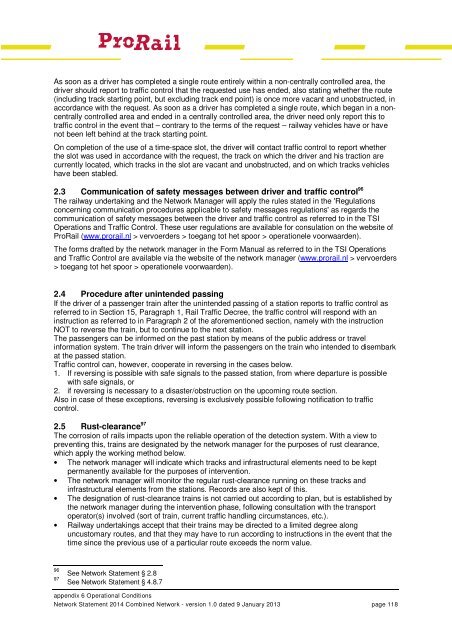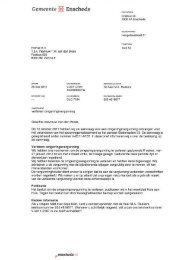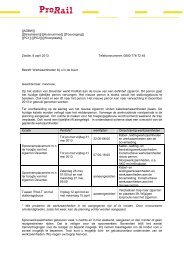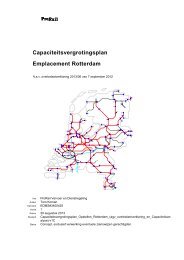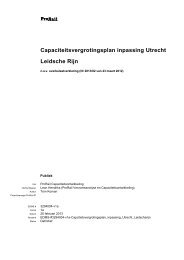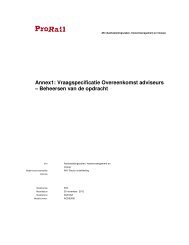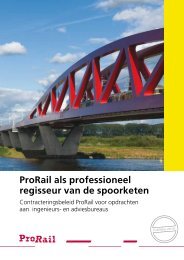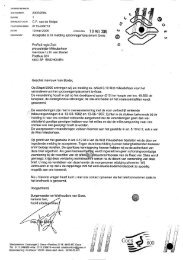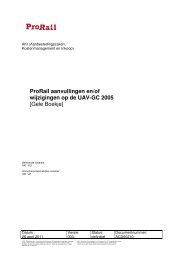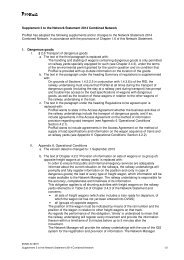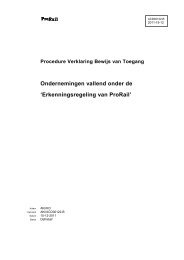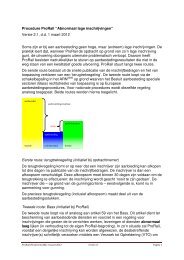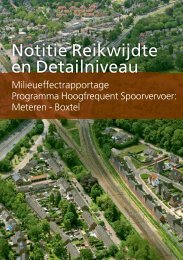Network Statement 2014 - ProRail
Network Statement 2014 - ProRail
Network Statement 2014 - ProRail
- No tags were found...
Create successful ePaper yourself
Turn your PDF publications into a flip-book with our unique Google optimized e-Paper software.
As soon as a driver has completed a single route entirely within a non-centrally controlled area, thedriver should report to traffic control that the requested use has ended, also stating whether the route(including track starting point, but excluding track end point) is once more vacant and unobstructed, inaccordance with the request. As soon as a driver has completed a single route, which began in a noncentrallycontrolled area and ended in a centrally controlled area, the driver need only report this totraffic control in the event that – contrary to the terms of the request – railway vehicles have or havenot been left behind at the track starting point.On completion of the use of a time-space slot, the driver will contact traffic control to report whetherthe slot was used in accordance with the request, the track on which the driver and his traction arecurrently located, which tracks in the slot are vacant and unobstructed, and on which tracks vehicleshave been stabled.2.3 Communication of safety messages between driver and traffic control 96The railway undertaking and the <strong>Network</strong> Manager will apply the rules stated in the 'Regulationsconcerning communication procedures applicable to safety messages regulations' as regards thecommunication of safety messages between the driver and traffic control as referred to in the TSIOperations and Traffic Control. These user regulations are available for consulation on the website of<strong>ProRail</strong> (www.prorail.nl > vervoerders > toegang tot het spoor > operationele voorwaarden).The forms drafted by the network manager in the Form Manual as referred to in the TSI Operationsand Traffic Control are available via the website of the network manager (www.prorail.nl > vervoerders> toegang tot het spoor > operationele voorwaarden).2.4 Procedure after unintended passingIf the driver of a passenger train after the unintended passing of a station reports to traffic control asreferred to in Section 15, Paragraph 1, Rail Traffic Decree, the traffic control will respond with aninstruction as referred to in Paragraph 2 of the aforementioned section, namely with the instructionNOT to reverse the train, but to continue to the next station.The passengers can be informed on the past station by means of the public address or travelinformation system. The train driver will inform the passengers on the train who intended to disembarkat the passed station.Traffic control can, however, cooperate in reversing in the cases below.1. If reversing is possible with safe signals to the passed station, from where departure is possiblewith safe signals, or2. if reversing is necessary to a disaster/obstruction on the upcoming route section.Also in case of these exceptions, reversing is exclusively possible following notification to trafficcontrol.2.5 Rust-clearance 97The corrosion of rails impacts upon the reliable operation of the detection system. With a view topreventing this, trains are designated by the network manager for the purposes of rust clearance,which apply the working method below.• The network manager will indicate which tracks and infrastructural elements need to be keptpermanently available for the purposes of intervention.• The network manager will monitor the regular rust-clearance running on these tracks andinfrastructural elements from the stations. Records are also kept of this.• The designation of rust-clearance trains is not carried out according to plan, but is established bythe network manager during the intervention phase, following consultation with the transportoperator(s) involved (sort of train, current traffic handling circumstances, etc.).• Railway undertakings accept that their trains may be directed to a limited degree alonguncustomary routes, and that they may have to run according to instructions in the event that thetime since the previous use of a particular route exceeds the norm value.9697See <strong>Network</strong> <strong>Statement</strong> § 2.8See <strong>Network</strong> <strong>Statement</strong> § 4.8.7appendix 6 Operational Conditions<strong>Network</strong> <strong>Statement</strong> <strong>2014</strong> Combined <strong>Network</strong> - version 1.0 dated 9 January 2013 page 118


